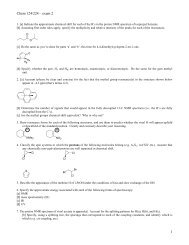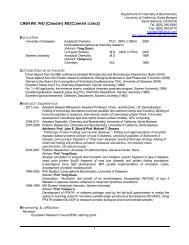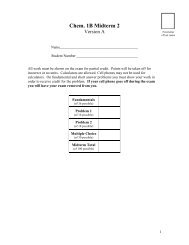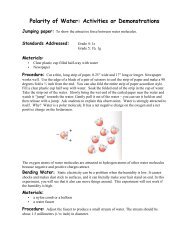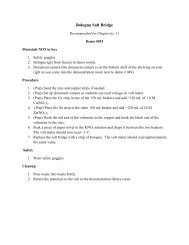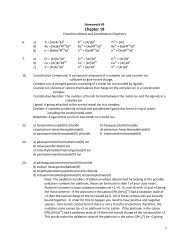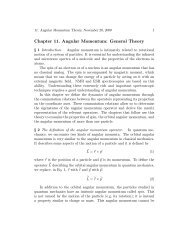Chapter 7. The Eigenvalue Problem
Chapter 7. The Eigenvalue Problem
Chapter 7. The Eigenvalue Problem
You also want an ePaper? Increase the reach of your titles
YUMPU automatically turns print PDFs into web optimized ePapers that Google loves.
<strong>7.</strong> <strong>The</strong> <strong>Eigenvalue</strong> <strong>Problem</strong>, December 17, 2009 7<br />
<strong>The</strong> column in the right-hand side is the zero vector. We can regard δ mn<br />
asbeingtheelementsofamatrixI, which is called the unit matrix (or the<br />
identity matrix):<br />
⎛<br />
⎞<br />
1 0 0 ······ 0<br />
0 1 0 ······ 0<br />
I =<br />
0 0 1 ······ 0<br />
(30)<br />
⎜<br />
. ⎝ . . . . . .<br />
⎟<br />
⎠<br />
0 0 0 ······ 1<br />
This has the property<br />
(Iv) m =<br />
N<br />
I mn v n =<br />
n=1<br />
N<br />
δ mn v n = v m<br />
n=1<br />
<strong>The</strong> m-th element of the vector Iv is v m ;thismeansthat<br />
<strong>The</strong> definition of I allows us to write Eq. 29 as<br />
A system of equations of the form<br />
Iv = v (31)<br />
(A − λI)ψ = 0 (32)<br />
Mv = 0, (33)<br />
where M is an N × N matrix and v is an N-dimensional vector, is called<br />
a homogeneous system of N linear equations. <strong>The</strong> name ‘homogeneous’ is<br />
given because the right-hand side is zero; this distinguishes it from<br />
Mv = u (34)<br />
which is an inhomogeneous system of N linear equations.<br />
Example. Let<br />
A =<br />
⎛<br />
⎜<br />
⎝<br />
3 2 4<br />
2 1.2 3.1<br />
4 3.1 4<br />
⎞<br />
⎟<br />
⎠ (35)




